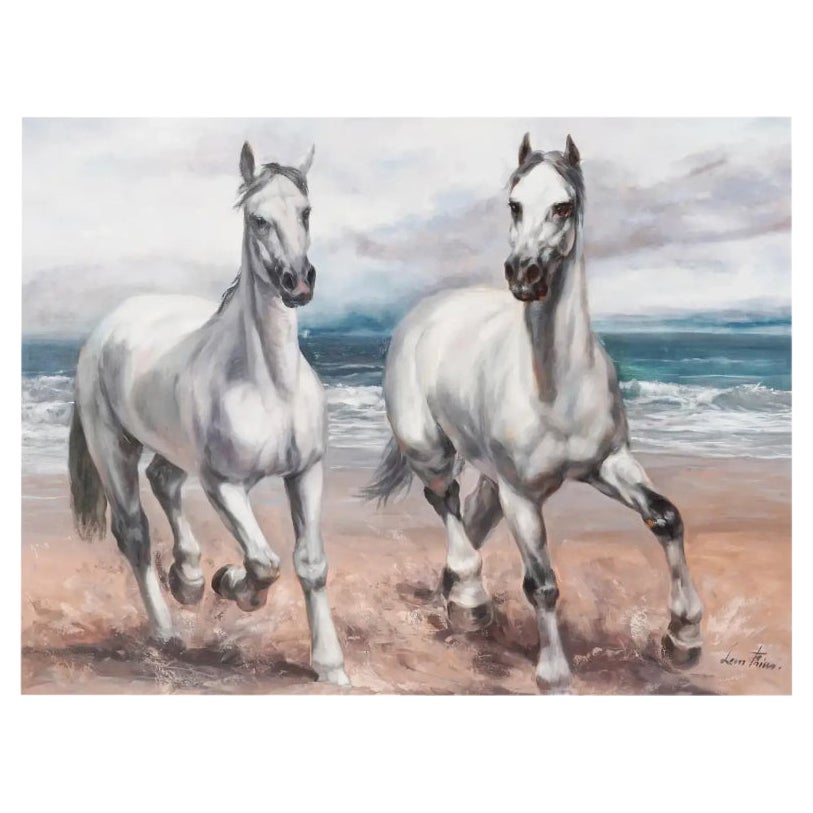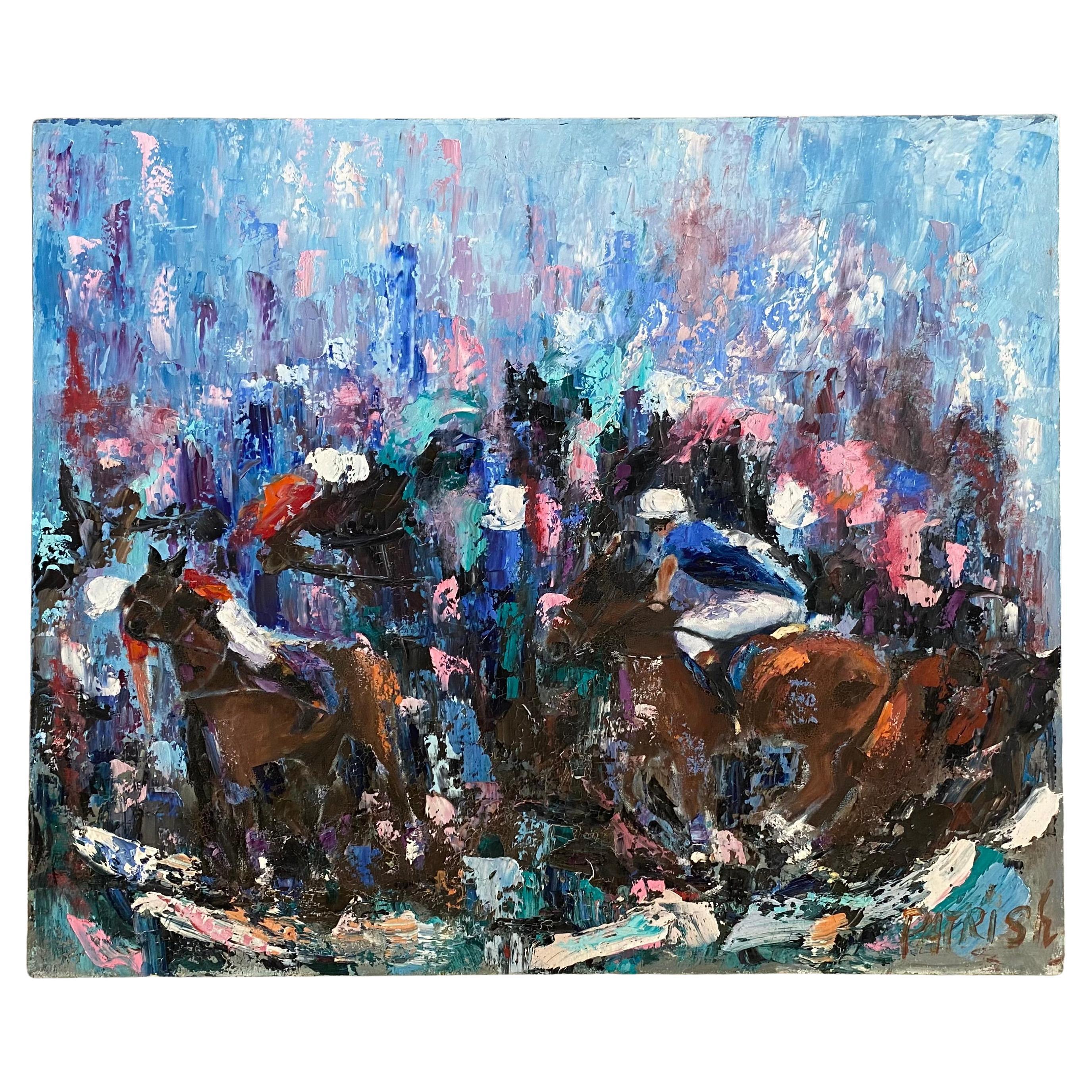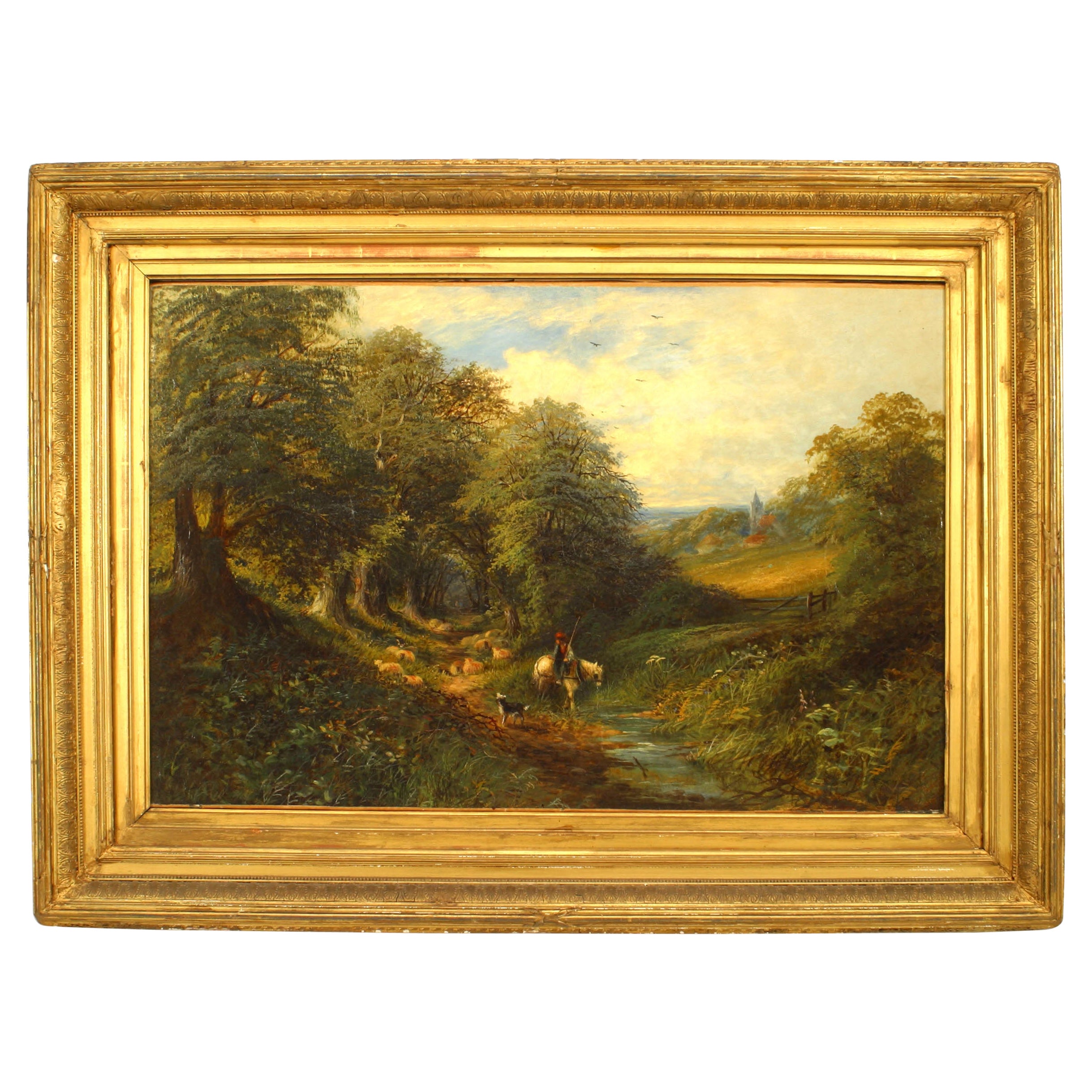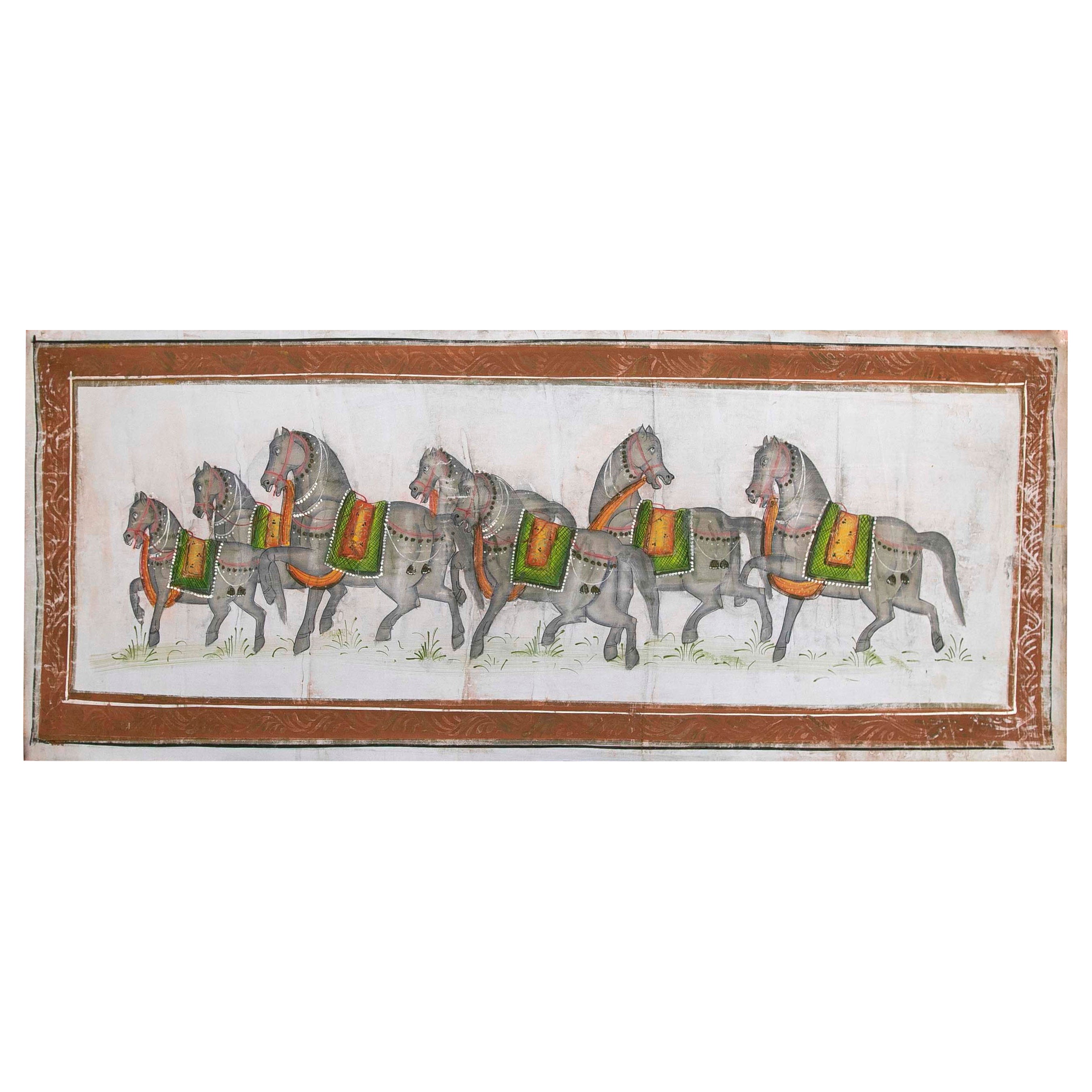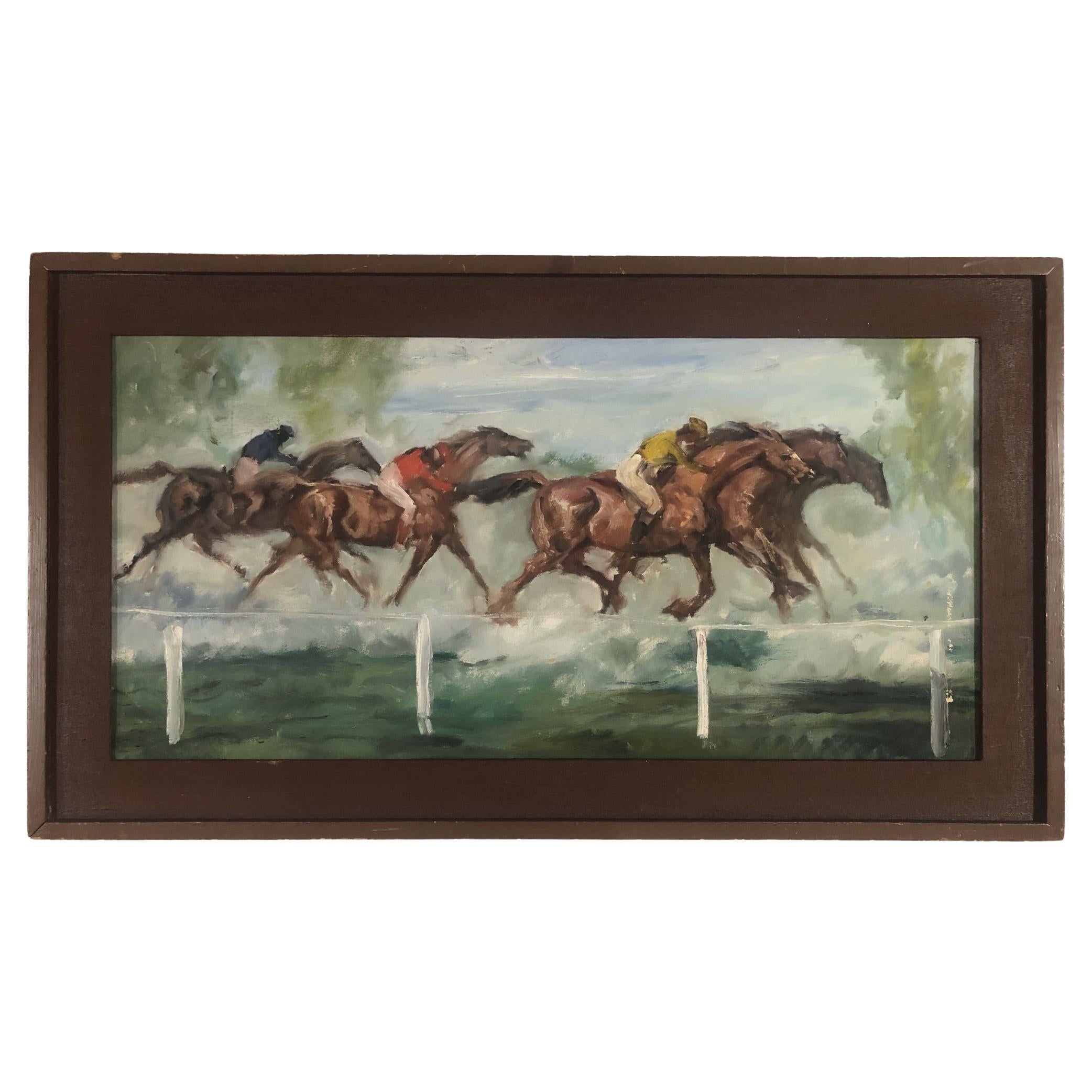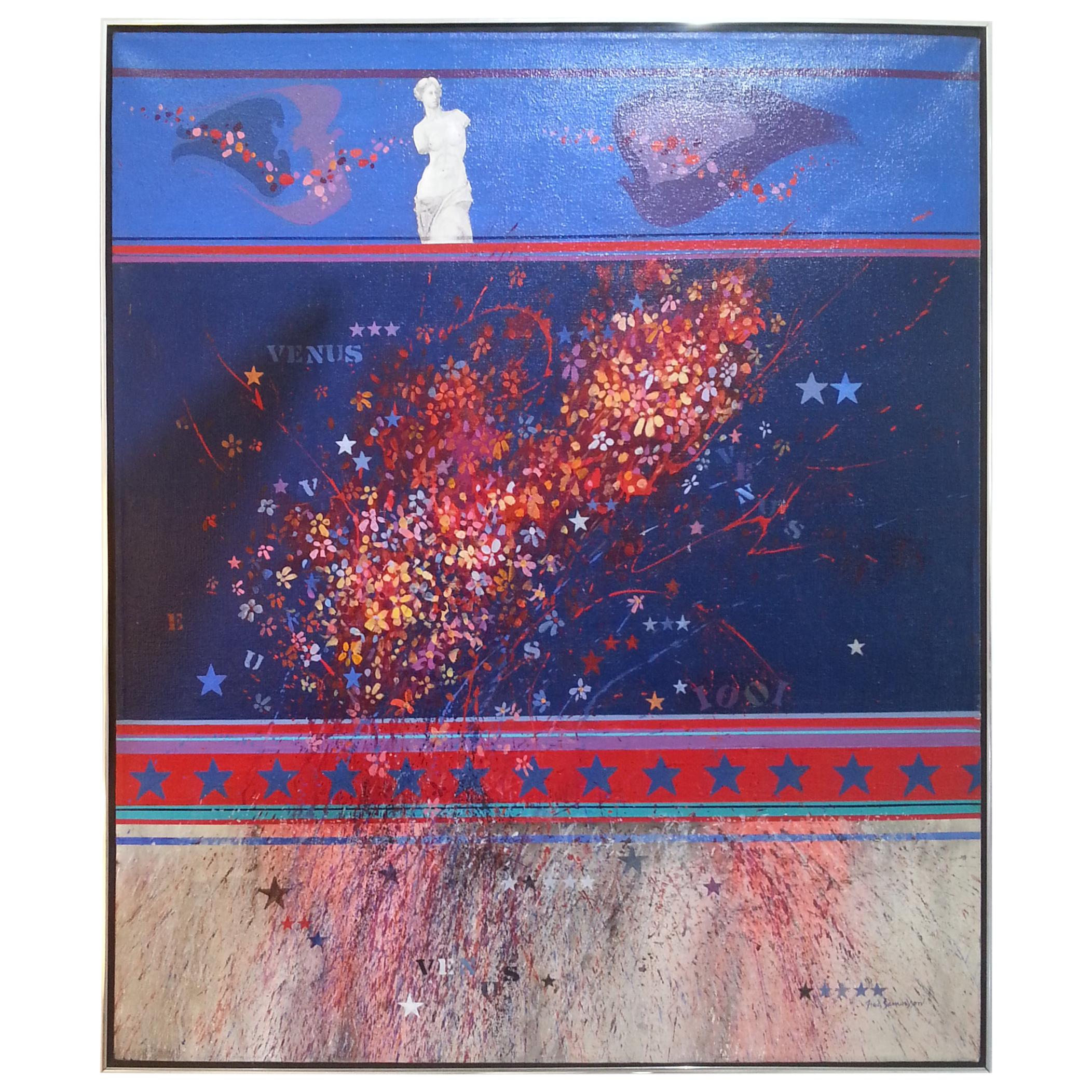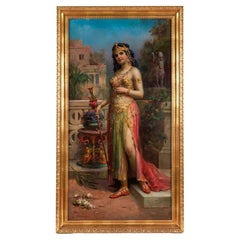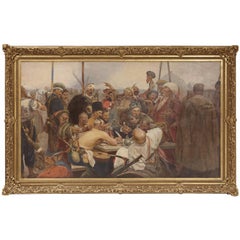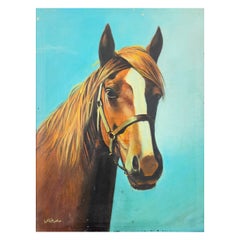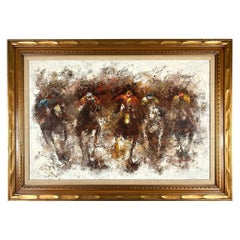
Nasser Ovissi, 'Iranian, "White Arabian Horse" Oil on Canvas Painting
View Similar Items
Nasser Ovissi, 'Iranian, "White Arabian Horse" Oil on Canvas Painting
About the Item
- Creator:Nasser Ovissi (Artist)
- Dimensions:Height: 24 in (60.96 cm)Width: 33 in (83.82 cm)Depth: 1 in (2.54 cm)
- Materials and Techniques:
- Place of Origin:
- Period:
- Date of Manufacture:circa 1990
- Condition:
- Seller Location:New York, NY
- Reference Number:1stDibs: LU1798215052452
Nasser Ovissi
Nasser Ovissi is an American-Iranian painter whose work is characterized by stylized figures of Arabic women and horses. Set amidst geometric patterns and decorative elements, his figures seem to merge into and out of the space behind them. Ovissi says, “My work is dedicated to the beauty of life and I hope those who experience my work will walk away with an experience of beauty.” Born in Tehran, Iran, in 1934, Ovissi studied law and political sciences at the University of Tehran before studying fine art at École des Beaux-Arts in Rome. Ovissi has achieved numerous awards and honors, including being exhibited at the 1959 La Biennale Paris and a grand prize at the 1962 Biennale of fine arts of Tehran. His works are included in the collections of the Contemporary Art Museum in Madrid and the National Art Gallery of Greece in Athens. Ovissi lives and works in Reston, Virginia.
- Emanuel Oberhauser, Full Length Portrait of an "Orientalist Queen" Oil on CanvasLocated in New York, NYEmanuel Oberhauser (Austrian, 1854-1919) an exceptional quality full length oil on canvas painting of a Young Orientalist Queen or Odalisque, 19th c...Category
Antique 19th Century Austrian Paintings
MaterialsPaint
- Reply of the Zaporozhian Cossacks to Sultan Mehmed IV Painting after Ilya RepinBy Ilya RepinLocated in New York, NYReply of the Zaporozhian Cossacks to Sultan Mehmed IV of the Ottoman Empire, also known as Cossacks of Saporog Are Drafting a Manifesto. Late 19th Century. Monumental oil on canvas, set within an original carved giltwood frame. Unsigned. Measures: Canvas: 62 X 105in (157 X 266cm). Frame: 80 X 123in (204 X 312cm). This painting is after Russian artist Ilya Repin...Category
Antique Late 19th Century Russian Paintings
MaterialsCanvas
- Palatial and Opulent Belle Epoque Giltwood & Oil on Canvas Three-Panel ScreenBy Ferdinand Wagner II 1Located in New York, NYA Palatial and Opulent Belle epoque giltwood & oil on canvas three-panel screen, circa 1890. "Allegory of Youth" Comprising of three exquisite hand-painted triptych oil on canvas panels of cherubs and putti amongst a peacock, all by Ferdinand Wagner II (German, 1847-1927). Each panel depicting different playful and joyous scenes of putti and cherubs. All three-in-one panels within individually carved giltwood and upholstered frames. One panel signed at the lower left: Ferd.Wagner. A truly magnificent and one of a kind piece, perfect for any room in the home. Overall: 101" high 85" wide x 5" deep Very good condition. Ready to place. Ferdinand Wagner II (German, 1847-1927) was the son of Passau Ferdinand Wagner Senior, a teacher at a vocational art school who began training him professionally at a young age. After traveling to Italy in 1867-1868, he continued with his art studies at The Munich Academy of Arts led by Peter Von Cornelius and Julius Schnorr Von Carolsfeld. Wagner II was influenced by the Munich School of master painters and by his art teacher, Karl von Piloty, who had been teaching at the Munich Art Academy since 1856. Piloty’s approach to historical paintings was influenced by the French art academic Paul Delaroche and by the fine artworks by Rubens and the Venetians. After his return to Germany he was commissioned to decorate the former the Tenormayer Wine Tavern in Munich, subsequently he received numerous other commissions as a decorator. Ferdinand Wagner II wall paintings and ceiling frescos...Category
Antique 19th Century German Belle Époque Screens and Room Dividers
MaterialsCanvas, Upholstery, Giltwood, Paint
- Isidore-Jules Bonheur, A Rare Gilt and Patinated Bronze Jockey on A HorseBy Isidore Jules BonheurLocated in New York, NYIsidore-Jules Bonheur (French, 1827–1901) A Rare Gilt and Patinated Bronze Jockey on A Horse, circa 1875. Introducing a truly exceptional and highly s...Category
Antique 19th Century French Sporting Art Animal Sculptures
MaterialsBronze
- Elizabeth II Sterling Silver and Ruby Humidor Box Made for Saudi ArabiaLocated in New York, NYElizabeth II Sterling Silver and Ruby Humidor Box Made for Saudi Arabia Made by Peter Nicholas & Co Ltd in London in 1989. Rectangular box with corner bracket supports and hinged ...Category
20th Century British Cigar Boxes and Humidors
MaterialsSterling Silver
- Mellerio Paris, A French Gold, Diamonds, Silver, and Smoky Quartz Carved HorseBy MellerioLocated in New York, NYMellerio Paris, A French Gold, Diamonds, Silver-Gilt, Rock-Crystal, Jade, Mother-Of-Pearl and Smoky Quartz, Carved Horse Sculpture, Jeweled Mounted Object. An extremely rare and unique, one of a kind French gold, diamonds, Silver-gilt, rock-crystal, jade, obsidian, mother-of-pearl, and smoky quartz carved jeweled sculpture "CHEVAUX DE LEGENDE", "A Legendary Horse" by Mellerio, Paris, circa 1991. Sitting on black obsidian base, the solid rock-crystal slab is finely applied with a carved smoky -quartz and jade horse with a harness mounted in 18k gold, brilliant -cut diamonds, rubies, turquoise, and amethyst chains and pendants. The top columns adorned with 18k gold and brilliant cut diamond pendants, the bottom with gold and mother of pearl plaques. The obsidian base with a plaque engraved: CHEVAUX DE LEGENDE" / N° 05 / MELLERIO DITS MELLER / PARIS / 5003 D The piece is in excellent condition and comes with a custom made wood case made for transport. It's very elegant and has French hallmarks throughout. A truly magnificent piece. Measures 10.5" high x 8.5" wide x 4" deep Founded in France in 1613 by the descendants of Italian immigrants from the Vigezzo Valley in the north of Italy, Mellerio is one of the oldest jewellery houses in Europe. The family business soon attracted the attention of the Royal Court and Marie Antoinette herself reportedly purchased a precious bracelet featuring 7 cameos surrounded by rubies in 1780. Later on, in the 19th century, Mellerio became the official supplier of the French Royal family and the Court of Netherland. Mellerio creates many jewellery items, all set with rare gems such as peridots, amethysts, aquamarines, citrines and topaz, applying for a patent, the flexible stem, a very supple and light jewellery mechanism. Mellerio remains also well known for their spectacular series of Art Nouveau jewels, created at the beginning of the 20th century, as well as for the creation of trophies rewarding some of the greatest footfall and tennis players of history. In 1993, the jewellery house launched their first watch collection. Today, Mellerio has stores in Paris, Japan and Hong Kong. July 14, 1789: this date is known throughout the world as the beginning of the French Revolution. According to a ledger belonging to House of Mellerio, this was also the day that the jeweler sold a golden key to the Comte de Coutance for 10 livres. This ledger, as well as inventories dating as far back as 1768, are the jeweler’s oldest archives. These archives have continued to grow over the years, as the House, established on rue de la Paix in Paris, still lives on today, still in the hands of the same family from Craveggia, in the North of Italy. The tumultuous history of the Mellerio family in France probably goes as far back as the Italian wars of the Renaissance, but the first official document proving their commercial activity in Paris dates back to 1613. This document is the famous royal warrant awarded by Marie de Medici to a number of Italian families established along the rue des Lombards, including the Mellerios, allowing them to sell “small jewelery items”, therefore granting them a small exception to the traditional monopoly enjoyed by Parisian jewelers. At that time, powerful corporations regulated the operations and customs of Parisian business, but thanks to this exceptional warrant, the Mellerios managed to escape the confines of this framework. Today, this wax-sealed document is kept at the city hall of Craveggia. From 1613 to the Revolution, the Mellerios lived between France and Italy. The corporations tried many times to put an end to their trade privileges, but all in vain, as a dynasty of sovereigns renewed the warrant. Always marrying and often retiring in Craveggia, the Mellerios continued to maintain their jewelry business in Paris. At first, they did this without a shop. Wearing backpacks (wooden boxes divided into small compartments where jewels were kept), they would tour town fairs around Paris and royal castles. This is how Jean-Baptiste Mellerio (1765-1850) is said to have sold a bracelet set with rubies and Antique cameos to Marie-Antoinette, which still exists today. Many elements seem to prove the veracity of this anecdote. The queen was particularly fond of cameos, which cover the entire background of her famous jewelry cabinet, and ruby was her favorite stone after diamond. The famous bracelet, reacquired a few years ago by the House of Mellerio, is indeed an 18th century jewel, set with antique cameos representing the profiles of Roman emperors. Two branches of the family were operating in Paris during this time, under the reign of Louis XVI: that of Jean-François (1746-1828), the paternal ancestor of the current Mellerios, and that of Jean-Baptiste (1765-1850). The French Revolution forced them to return to Italy. However, both Jean-Baptiste and François Mellerio (1772-1843), who was the son of Jean-François, were eventually able to return to Paris after the founding of the Consulate. Jean-Baptiste opened a shop at the Iron Crown of rue Vivienne, and François opened his at the Palais des Tuileries, rue du Coq Saint-Honoré. His well-organized order books give an idea of his high-ranking clientele during the “Old Regime”, among which were the Comte and Comtesse Octave de Segur, the Marquise (later Duchess) de Tourzel, former governess of the royal children, and her daughter, the Comtesse de Bearn, the Craufurds -who organized the flight to Varennes, the Duc and Duchess de Gramont, the Comtesse de Boigne, and Madame de Souza, Talleyrand’s mistress. We also see the names of the imperial family: Empress Josephine, the Queen of Holland, Princess Elisa, Caroline and Pauline. At that time, the House of Mellerio specialized, among other things, in the trade of antique cameos, a newly fashionable genre of jewel that captured the imagination of all the princesses and noble women of the time. The years of the Restauration and July Monarchy were among the most glorious. The Bourbons were back on the throne, and the clientele of the House of Mellerio had regained its former wealth. Mellerio supplied Louis-Philippe, Duke of Orléans, as well as his mother, wife and sister, with sumptuous jewels, including a set of emeralds made piece by piece, while the Duke of Bourbon, last prince of the House of Condé, offered diamonds to his mistress, the scheming Baronne de Feucheres, and Monsieur de LaFayette also bought cameos for one of his granddaughters. For the first time, Mellerio ventured into the world of arts in 1815, when Carlotta Grisi, a famous dancer who created Giselle, as well as an actress named Rachel, bought jewels at the Mellerio store on rue de la Paix. 1848 marked a new turning point. France once again became a Republic. François Mellerio handed the company over to his son, Jean, and the latter decided to travel to Spain to build a new clientele. He later became one of the jewelers of the royal family, and met Eugénie de Montijo, who remained a faithful client when she became empress of the French people. The Imperial years were lavish. During the Second Empire, Paris was a pageant of crinoline dresses designed by Worth, while jewels by Mellerio, Worth’s neighbour on the rue de la Paix, adorned the noble women of the Tuileries court. The Empress bought pearls. Mathilde Bonaparte...Category
20th Century French Mounted Objects
MaterialsJade, Quartz, Rock Crystal, Gold, Silver
- Oil on Canvas Arabian Horse PaintingLocated in London, GBA fine Arabian horse painting on a sky blue background signed lower left, Circa 1970 - 80. Dimensions: H: 88cm, W: 79cm. Canvas: H: 79cm,...Category
20th Century Asian Paintings
MaterialsCanvas
- Horse Racing Oil On Canvas PaintingLocated in Pomona, CAFour jockeys on the horse are competing on the horse track. The size without the frame is 35.50" W, 23.50"HCategory
Vintage 1960s American Paintings
MaterialsCanvas, Wood, Paint
- 18th Century Oil on Canvas Study of Arabian White Stallion Horse Attributed TLocated in New York, NY18th Century oil on canvas study of an Arabian white stallion horse. Attributed to Alfred De Dreux In wonderful frame ready to hang Frame is 19 ...Category
Antique 18th Century North American Paintings
MaterialsPaint
- Modern Arabian Horses Oil Painting by Leon FriasLocated in New York, NYLeon Frias, Spanish, born 1946, oil painting on canvas, Arabian Stallions on Beach. Signed lower right. Leon Frias is a Spanish artist known for la...Category
Late 20th Century Spanish Paintings
MaterialsPaint
- Abstract Oil on Canvas Painting Horse Racing, SignedLocated in Miami, FLOil on canvas abstract painting depicting figures and horse races. This bright and colorful artwork contains the use of bold, rapid brushstrokes and dynamic angles. Signed. Ar...Category
20th Century French Modern Paintings
MaterialsCanvas, Paint
- Painting of Two Horses in a Field, Oil on CanvasLocated in Cypress, CABeautiful oil on canvas painting of two horses in a field in front of a water basin. Signed W. Barr possibly is William Barr (1867-1933, Scotland). ...Category
Early 20th Century Paintings
MaterialsCanvas
